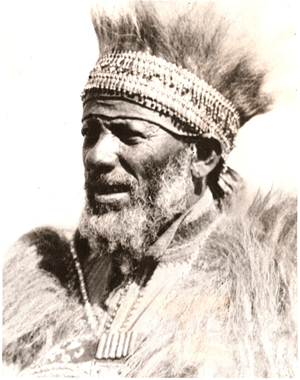

Hailu Tekle Haymanot, KBE (1868–1950), also named Hailu II of Gojjam, was an army
commander and a member of the nobility of the Ethiopian Empire. He represented a provincial
ruling elite who were often at odds with the Ethiopian central government.[1] Hailu Tekle
Haymanot was an independent-minded potentate who, throughout his life, was mistrustful and
mistrusted by the Emperor.[2]
In July 1936, a number of surviving Ethiopian soldiers staged an unsuccessful attack on Addis
Ababa to wrest control of the capital from the Italian occupiers. Hailu Tekle Haymanot played a
part in the surrender of two of the commanders of the attacking forces. Both commanders were
sons of Ras Kassa Haile Darge, Aberra Kassa and Asfawossen Kassa. Along with others, both
had taken part in the attack and, like most, they attempted to escape capture after the attack
failed. Hailu assured Aberra and Asfawossen that, if they surrendered, they would not be
harmed. On 21 December, both Aberra and Asfawossen turned themselves in at Fiche. However,
once in Italian captivity, they were both executed as rebels.[18][nb 13]
By 27 September 1939, during the Feast of Maskal in Addis Ababa, Ras Hailu Tekle Haymanot,
Ras Seyum Mangasha, and Ras Haile Selassie Gugsa sat with Amedeo, 3rd Duke of Aosta, the
Viceroy and Governor General of Italian East Africa (Africa Orientale Italiana, or AOI).[20] All
three Ethiopian leaders had submitted to Italian control of what had been their homeland and
what was now the AOI colony. The Italians eventually returned Hailu to power in Gojjam at the
very final stage of their occupation and as their rule began to collapse under the onslaught of
British, Commonwealth, and exiled Ethiopian forces.
In 1941, after Emperor Haile Selassie returned to power in Ethiopia, Ras Hailu Tekle Haymanot
again switched sides and handed Gojjam over to the Emperor. However, he first made sure that
Italian forces had safely evacuated Gojjam. Hailu returned to Addis Ababa with Haile Selassie.
He was forbidden from leaving Addis Ababa, but was accorded all the dignities of a senior
prince of the Imperial dynasty and head of the House of Gojjam. In the words of Gebru Tareke,
he "languished in well-merited obscurity until his death in 1950," which "put the final nail in the
coffin of the provincial ruling elite, who had been grudgingly yielding ground to the centralists
since the closing decade of the nineteenth century."[1] His funeral was attended by the Emperor
and his family and he was accorded a state funeral.
Source : http://en.wikipedia.org/wiki/Hailu_Tekle_Haymanot